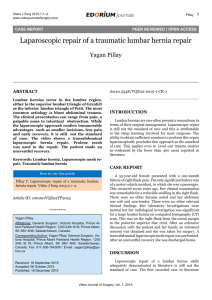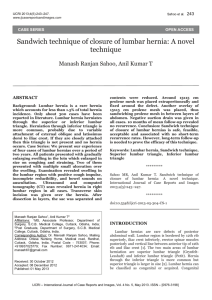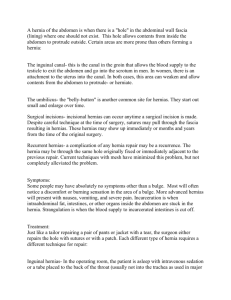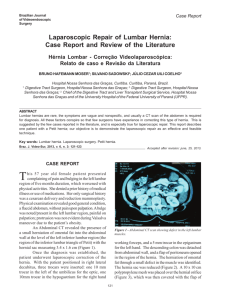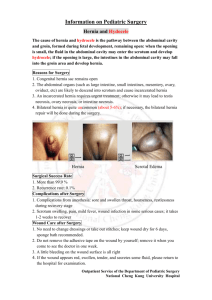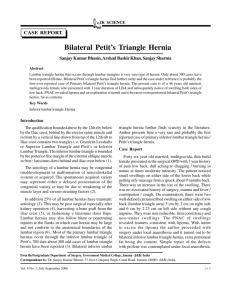Lumbar Hernia Treated with Lightweight Partially Absorbable Mesh
advertisement
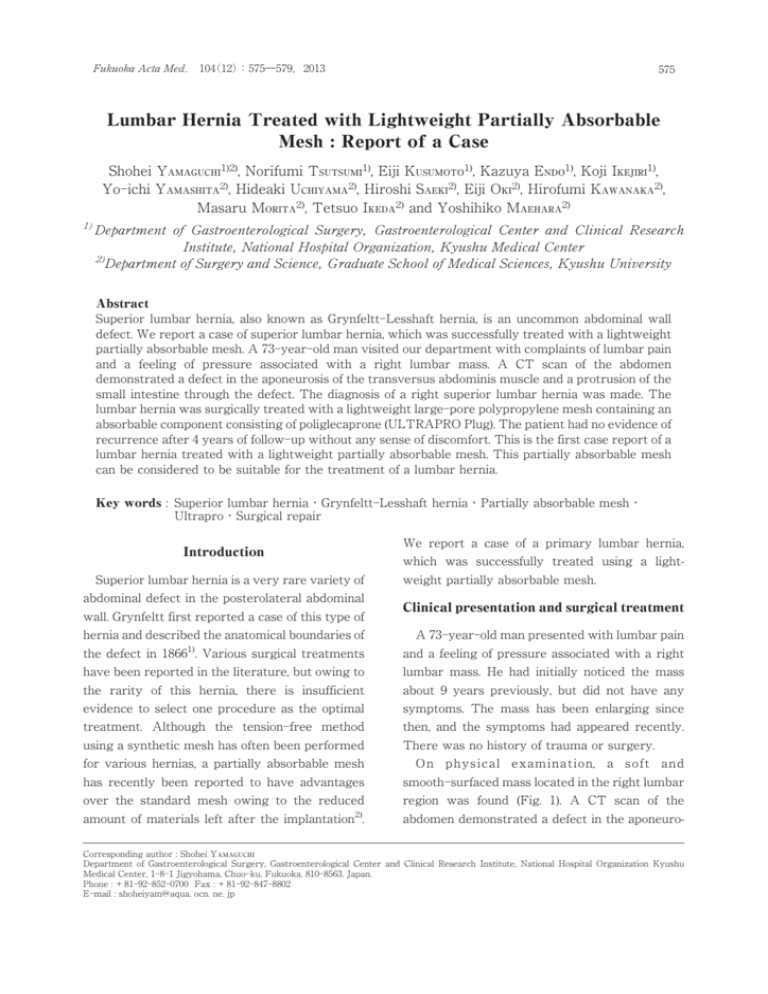
Fukuoka Acta Med. 104(12):575―579,2013 575 Lumbar Hernia Treated with Lightweight Partially Absorbable Mesh : Report of a Case Shohei YAMAGUCHI1)2), Norifumi TSUTSUMI1), Eiji KUSUMOTO1), Kazuya ENDO1), Koji IKEJIRI1), Yo-ichi YAMASHITA2), Hideaki UCHIYAMA2), Hiroshi SAEKI2), Eiji OKI2), Hirofumi KAWANAKA2), Masaru MORITA2), Tetsuo IKEDA2) and Yoshihiko MAEHARA2) 1) Department of Gastroenterological Surgery, Gastroenterological Center and Clinical Research Institute, National Hospital Organization, Kyushu Medical Center 2) Department of Surgery and Science, Graduate School of Medical Sciences, Kyushu University Abstract Superior lumbar hernia, also known as Grynfeltt-Lesshaft hernia, is an uncommon abdominal wall defect. We report a case of superior lumbar hernia, which was successfully treated with a lightweight partially absorbable mesh. A 73-year-old man visited our department with complaints of lumbar pain and a feeling of pressure associated with a right lumbar mass. A CT scan of the abdomen demonstrated a defect in the aponeurosis of the transversus abdominis muscle and a protrusion of the small intestine through the defect. The diagnosis of a right superior lumbar hernia was made. The lumbar hernia was surgically treated with a lightweight large-pore polypropylene mesh containing an absorbable component consisting of poliglecaprone (ULTRAPRO Plug). The patient had no evidence of recurrence after 4 years of follow-up without any sense of discomfort. This is the first case report of a lumbar hernia treated with a lightweight partially absorbable mesh. This partially absorbable mesh can be considered to be suitable for the treatment of a lumbar hernia. Key words : Superior lumbar hernia・Grynfeltt-Lesshaft hernia・Partially absorbable mesh・ Ultrapro・Surgical repair We report a case of a primary lumbar hernia, Introduction which was successfully treated using a light- Superior lumbar hernia is a very rare variety of abdominal defect in the posterolateral abdominal wall. Grynfeltt first reported a case of this type of hernia and described the anatomical boundaries of 1) weight partially absorbable mesh. Clinical presentation and surgical treatment A 73-year-old man presented with lumbar pain the defect in 1866 . Various surgical treatments and a feeling of pressure associated with a right have been reported in the literature, but owing to lumbar mass. He had initially noticed the mass the rarity of this hernia, there is insufficient about 9 years previously, but did not have any evidence to select one procedure as the optimal symptoms. The mass has been enlarging since treatment. Although the tension-free method then, and the symptoms had appeared recently. using a synthetic mesh has often been performed There was no history of trauma or surgery. for various hernias, a partially absorbable mesh On physical examination, a soft and has recently been reported to have advantages smooth-surfaced mass located in the right lumbar over the standard mesh owing to the reduced region was found (Fig. 1). A CT scan of the 2) abdomen demonstrated a defect in the aponeuro- amount of materials left after the implantation . Corresponding author : Shohei YAMAGUCHI Department of Gastroenterological Surgery, Gastroenterological Center and Clinical Research Institute, National Hospital Organization Kyushu Medical Center, 1-8-1 Jigyohama, Chuo-ku, Fukuoka, 810-8563, Japan. Phone : + 81-92-852-0700 Fax : + 81-92-847-8802 E-mail : shoheiyam@aqua. ocn. ne. jp 576 S. Yamaguchi et al. Fig. 1 A huge soft and smooth-surfaced mass was located in the right lumbar region. Fig. 2 Computed tomography showed protrusion of the small intestine through the defect in the right superior lumbar triangle. plug containing an absorbable component consisting of poliglecaprone (ULTRAPRO Plug, medium size) was used to reinforce the defect. The anchor of the plug was inserted into the extraperitoneal cavity, and the rim was placed over the defect and sutured to the fascia of the surrounding muscle using absorbable sutures. The patient recovered uneventfully and was discharged on the ninth Fig. 3 The lumbar hernia was surgically treated with a lightweight partially absorbable mesh. postoperative day. The patient had no evidence of recurrence at the 4-year follow-up (Fig. 3). Discussion sis of the transversus abdominis muscle and a protrusion of the small intestine through the A lumbar hernia is a protrusion of intraabdo- defect (Fig. 2). The diagnosis of a right superior minal or extraperitoneal organs of the abdomen lumbar hernia was made and a surgical procedure through a defect in the posterolateral abdominal was performed. wall. This type of hernia is very rare, and only With the patient in the left lateral position, a transverse incision was made over the apex of the about 300 cases have been reported in the literature3). hernia. After the subcutaneous tissue was dis- Barbette first suggested the existence of a sected, a hernia sac was found in the center of the lumbar hernia in 16724). The first case of a lumbar superior lumbar triangle. The hernia orifice was hernia was reported by Garangeot in 17315). In 3cm in diameter. The hernia sac was opened and 1783, Petit delineated the anatomical borders of the connection into the peritoneal cavity was the inferior lumbar triangle and reported a case of identified. Although the hernia content had a strangulated lumbar hernia6). Since then, all already been reduced, intraperitoneal fat tissue lumbar hernias have been thought to originate was adherent to the hernia sac. Therefore, the from the inferior lumbar triangle. However, hernia sac including the fat tissue was resected Grynfeltt identified the boundaries of the superior and the peritoneal defect was closed with sutures. lumbar triangle in 18661) and Lesshaft further A lightweight large-pore polypropylene mesh described the same anatomical area in 18707). The Lumbar hernia repair 577 boundaries of the superior lumbar triangle a fascial rotation flap14) or free fascial grafts15). (Grynfeltt-Lesshaft triangle) are the internal Currently, various synthetic meshes have been oblique muscle anteriorly, the sacrospinalis mus- developed and are often used to reinforce the cle posteriorly, and the twelfth rib and serratus defect16). Although the open approach with a posterior inferior muscle superiorly. The roof is posterior oblique incision is preferred by many formed by the latissimus dorsi muscle, and the surgeons, transabdominal and extraperitoneal floor is formed by the aponeurosis of the laparoscopic procedures have also been reported transversus abdominis muscle. On the other hand, as alternatives to the open approach8)17)18). the boundaries of the inferior lumbar triangle In a recent study, the benefits of using a new (Petit triangle) consist of the external oblique partially absorbable mesh for hernia repair were muscle anteriorly, the latissimus dorsi muscle demonstrated based on the reduced amount of posteriorly and the iliac crest inferiorly. The roof materials that persist in the host tissue after the is the superficial fascia and the floor is the internal implantation, which leads to diminished fore- oblique muscle. Overall, 95% of lumbar hernias ign-body reactions and less fibrosis in the host are reported to arise from these two spaces of the tissue. Such phenomena can decrease a certain lumbar wall. It has been reported that lumbar degree of the rigidity, producing discomfort for hernias arise more frequently in the superior the patient. Furthermore, absorbable meshes can 8) lumbar triangle than in the inferior triangle . maintain the same tensile strengths against the Lumbar hernias include congenital and ac9) quired hernias . About 20% of lumbar hernias are 10) reported to be congenital , and these are often 11) associated with anomalies in children or infants . repair zone as standard nonabsorbable meshes since they induce good recipient ingrowth of the host tissue, which can contribute to less recurrence2). About 80% of lumbar hernias are acquired12), and Recently, several reports have demonstrated these can be divided into primary and secondary that inguinal hernia repair using partially absorb- hernias. Primary lumbar hernias mainly occur in able meshes improves the quality of life of the elderly patients, and are estimated to represent patients and the functional outcomes19)20). In the about 55% of the lumbar hernias often found in the present case, we selected a partially absorbable 13) left side and in the superior lumbar triangle . mesh for a lumbar hernia, and placed it over the They may be associated with increased intraabdo- defect in the aponeurosis of the transversus minal pressure, such as physical activity or abdominis muscle. The postoperative course was 3) chronic bronchitis . Anatomical alterations of the uneventful and the patient has no sense of posterior abdominal wall owing to aging or discomfort at present. No cases of a lumbar hernia extreme thinness can also cause these hernias. treated with a partially absorbable mesh have Secondary lumbar hernias are reported to previously been reported, and we believe this is account for 25% of lumbar hernias13). The causes the first such case. Although long-term follow-up are surgical incisions, flank or lumbar traumas, is needed, a lightweight partially absorbable mesh 12) and retroperitoneal abscesses or hematomas . The only treatment for a lumbar hernia is seems to be comparable with other techniques and is also suitable for a lumbar hernia. surgical repair of the defective wall. For small References hernias, the defect can be securely repaired by simple closure of the aponeurosis or approximating the transversalis fascia. For large hernias, simple closure is not sufficient and tension-free methods have been adapted using a fascial strip13), 1) Grynfeltt J : Quelque mots sur la hernie lombaire. Montp Med 16 : 323, 1866. 2) Bellón JM, Rodríguez M, García-Honduvilla N, Pascual G and Buján J : Partially absorbable 578 3) 4) 5) 6) 7) 8) 9) 10) 11) 12) S. Yamaguchi et al. meshes for hernia repair offer advantages over nonabsorbable meshes. Am J Surg 194 : 68-74, 2007. Moreno-Egea A, Baena EG, Calle MC, Martínez JA and Albasini JL : Controversies in the current management of lumbar hernias. Arch Surg 142 : 82-88, 2007. Jeannel M : La hernie lombaire. Arch Prov Chir Paris 11 : 389-413, 1903. Grangeozt RJ : Colon traite d'operation. Chirurgie 1 : 369-370, 1731. Petit JL : Traite des Maladies Chirurgicales, et des Operations Qui Leur Conviennent. Paris, France. TF Didot 2 : 256-259, 1774. Thorek M : Lumbar hernia. J Int Coll Surg 14 : 367-393, 1950. Heniford BT, Iannitti DA and Gagner M : Laparoscopic inferior and superior lumbar hernia repair. Arch Surg 132 : 1141-1144, 1997. Stamatiou D, Skandalakis JE, Skandalakis LJ and Mirilas P : Lumbar hernia : surgical anatomy, embryology, and technique of repair. Am Surg 75 : 202-207, 2009. Geis WP and Saletta JD : Lumbar hernia. In : Nyhus LM, Condon RE (eds) Hernia 3rd. JB Lippincott, Philadelphia, pp 401-415, 1989. Wakhlu A and Wakhlu AK : Congenital lumbar hernia. Pediatr Surg Int 16 : 146-148, 2000. Burt BM, Afifi HY, Wantz GE and Barie PS : Traumatic lumbar hernia : report of cases and comprehensive review of the literature. J 13) 14) 15) 16) 17) 18) 19) 20) Trauma 57 : 1361-1370, 2004. Swartz WT : Lumbar hernias. J Ky Med Assoc 52 : 673-678, 1954. Dowd CN : Congenital lumbar hernia at the triangle of Petit. Ann Surg 45 : 245, 1907. Ravadin IS : Lumbar Hernia through Grynfeltt (sic) and Lesgaft's (sic) triangle. Surg Clin North Am 3 : 267, 1923. Cavallaro G, Sadighi A, Miceli M, Burza A, Carbone G and Cavallaro A : Primary lumbar hernia repair : the open approach. Eur Surg Res 39 : 88-92, 2007. Habib E : Retroperitoneoscopic tension-free repair of lumbar hernia. Hernia 7 : 150-152, 2003. Iannitti DA and Biffl WL : Laparoscopic repair of traumatic lumbar hernia. Hernia 11 : 537-540, 2007. Holzheimer RG : First results of Lichtenstein hernia repair with Ultrapro-mesh as cost saving procedure-quality control combined with a modified quality of life questionnaire (SF-36) in a series of ambulatory operated patients. Eur J Med Res 9 : 323-327, 2004. Akolekar D, Kumar S, Khan LR, de Beaux AC and Nixon SJ : Comparison of recurrence with lightweight composite polypropylene mesh and heavyweight mesh in laparoscopic totally extraperitoneal inguinal hernia repair : an audit of 1,232 repairs. Hernia 12 : 39-43, 2008. (Received for publication October 10, 2013) Lumbar hernia repair 579 (和文抄録) 軽量半吸収性メッシュを用いて治療し得た上腰ヘルニアの一例 1) 国立病院機構 九州医療センター 消化器センター外科 2) 九州大学大学院医学研究院 消化器・総合外科 山 口 将 平1)2),堤 敬 文1),楠 元 英 次1),遠 藤 和 也1),池 尻 公 二1), 山 下 洋 市2),内 山 秀 昭2),佐 伯 浩 司2),沖 英 次2),川 中 博 文2), 森田 勝2),池 田 哲 夫2),前 原 喜 彦2) Grynfeltt-Lesshaft ヘルニアとして知られる上腰ヘルニアは,稀な腹壁欠損疾患である.我々は, 軽量半吸収性メッシュを用いて治療し得た上腰ヘルニアの一例を経験したので報告する.73 歳男 性が腰痛と右腰部腫瘤による圧迫感を主訴に,当科を受診した.CT では右腹横筋腱膜の欠損と欠 損部からの小腸の脱出を認め,右上腰ヘルニアと診断した.この右上腰ヘルニアは吸収成分を含む 軽量ポリプロピレンメッシュ(ULTRAPRO Plug)を用いて,外科的に治療した.術後 4 年間,不 快感なしに再発なく経過している.当症例は腰ヘルニアに対して軽量部分吸収性メッシュを用い て治療した初めての症例である.軽量部分吸収性メッシュは,腰ヘルニア治療に対して有用である と考えられる.



